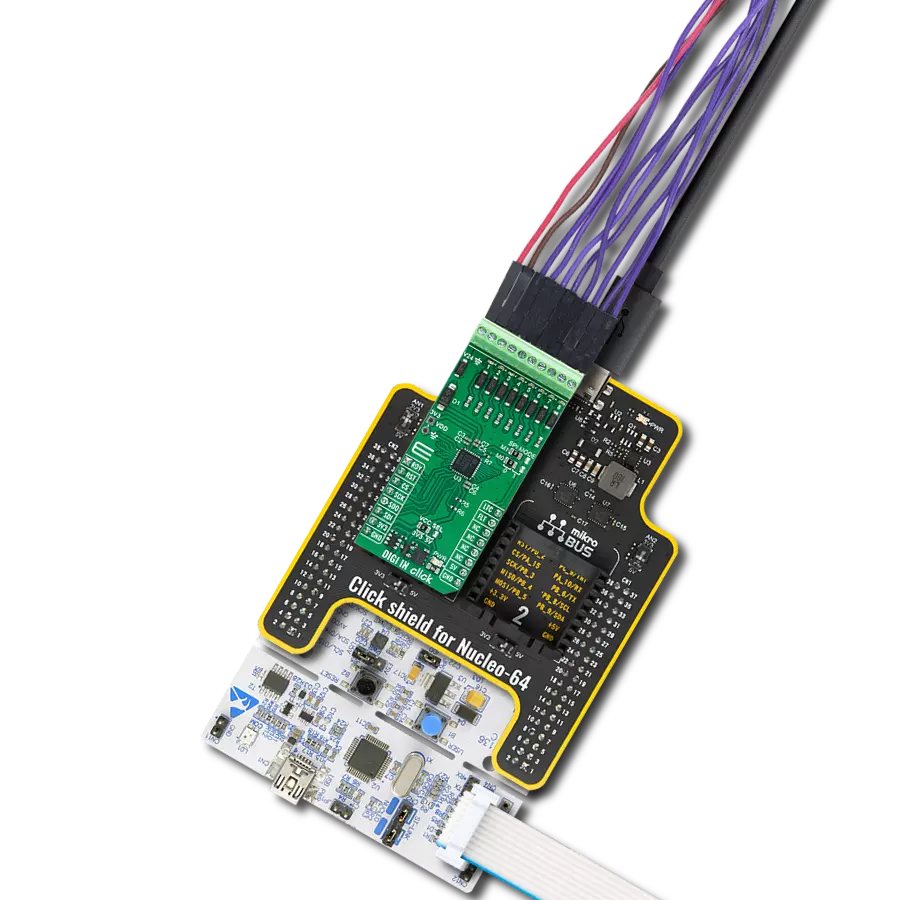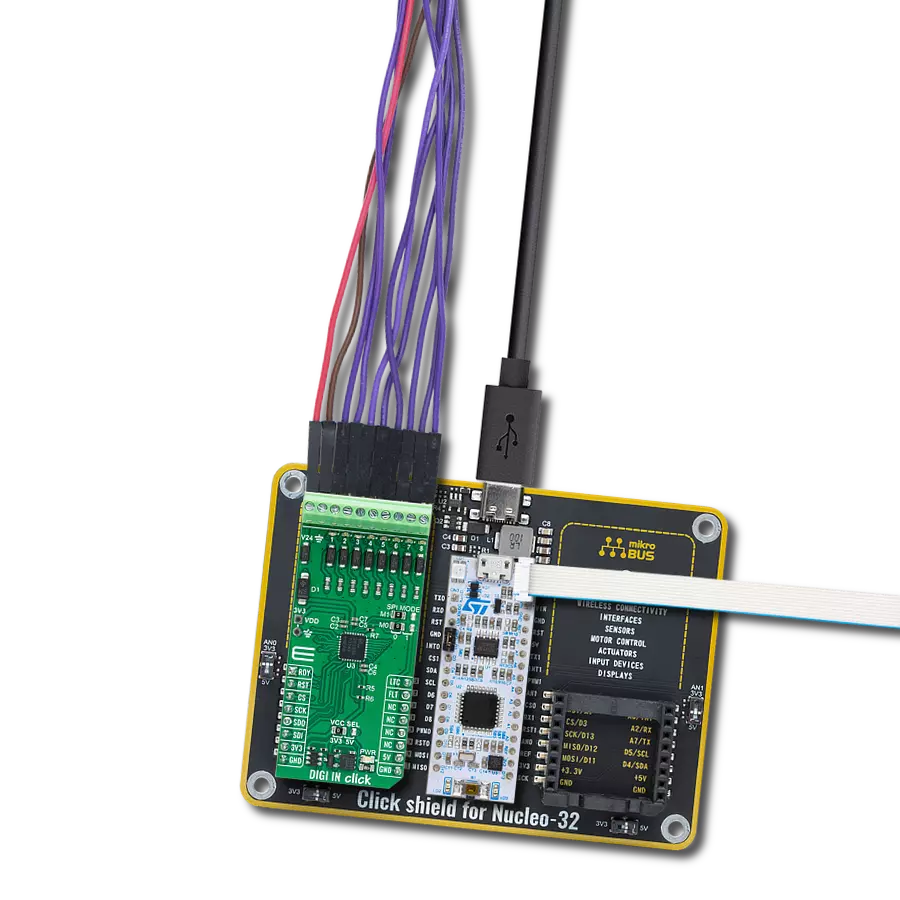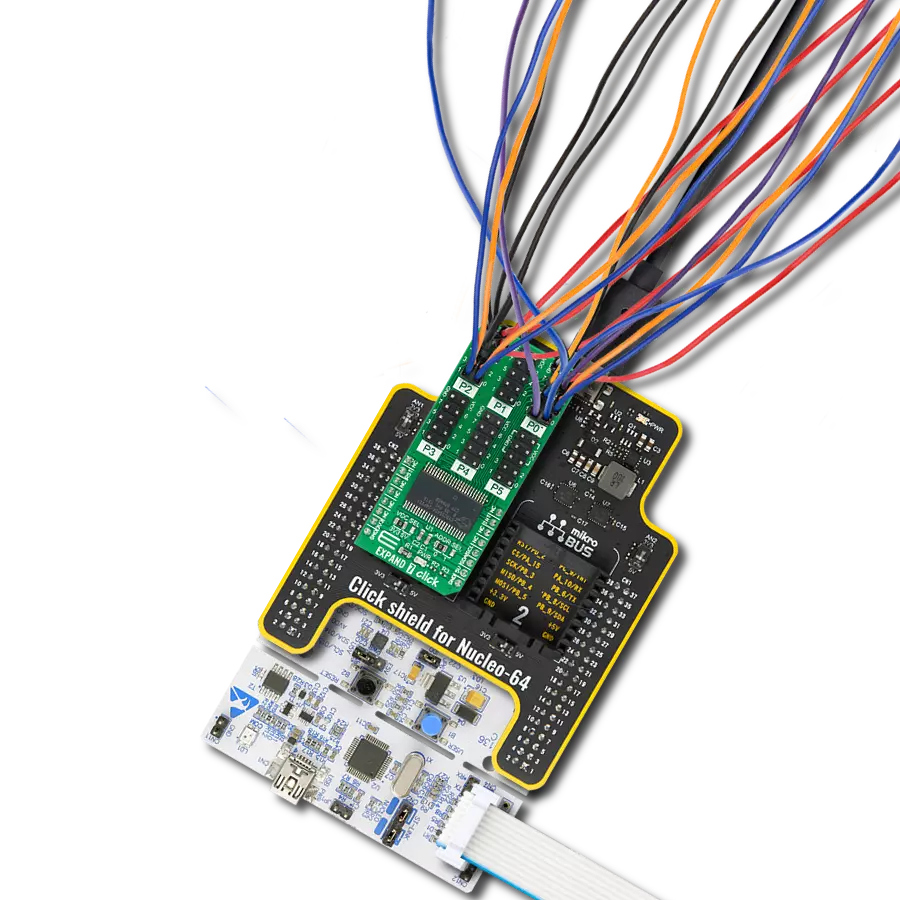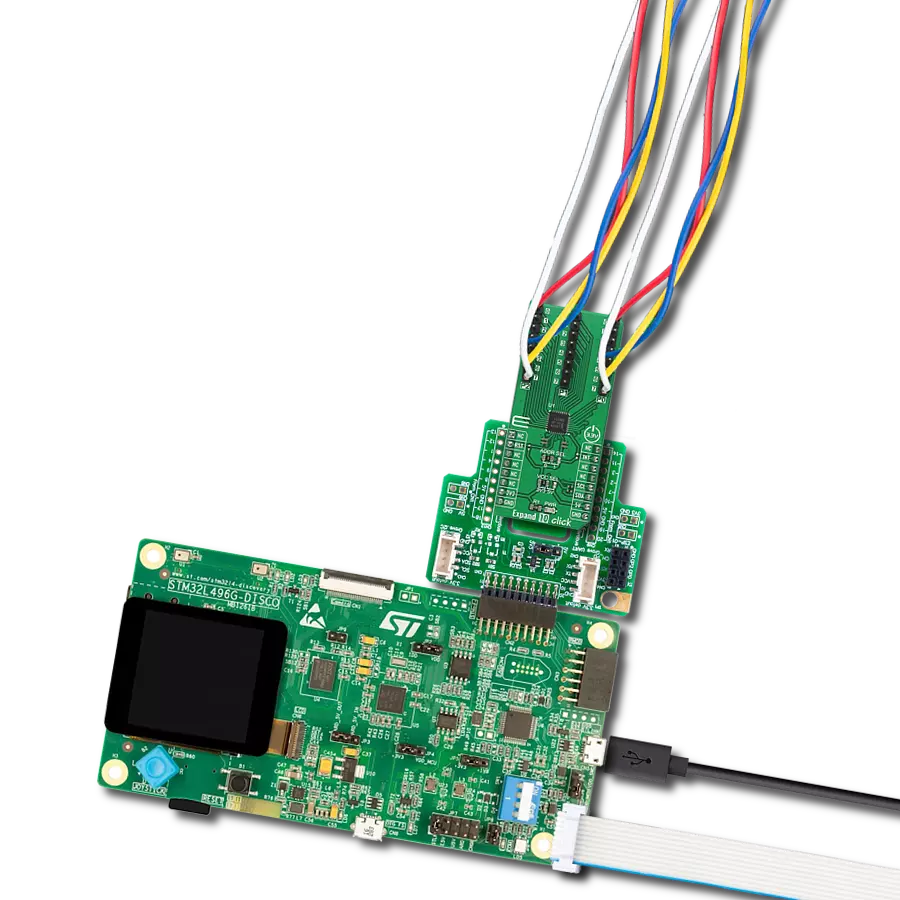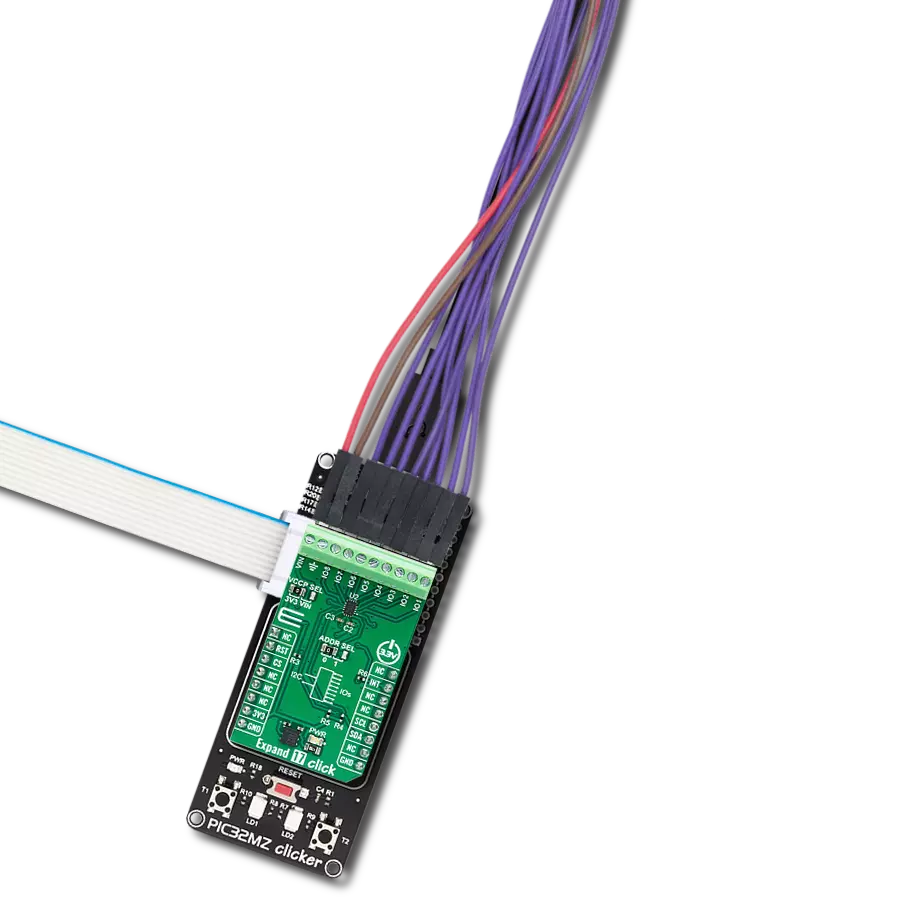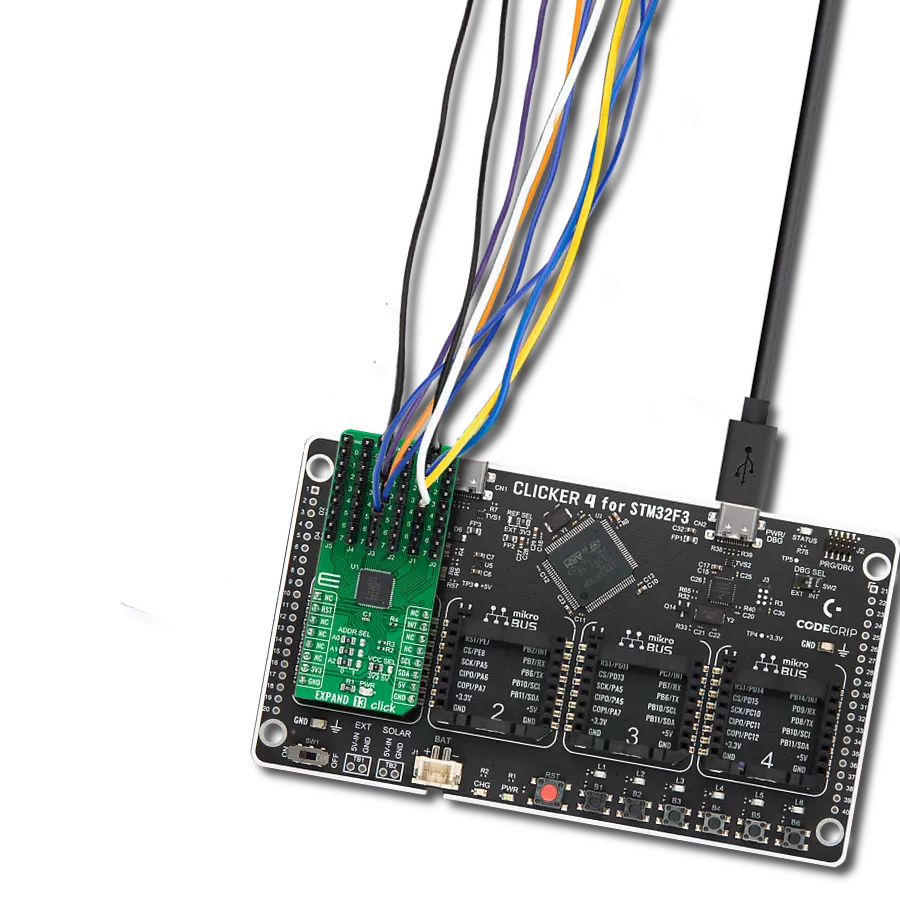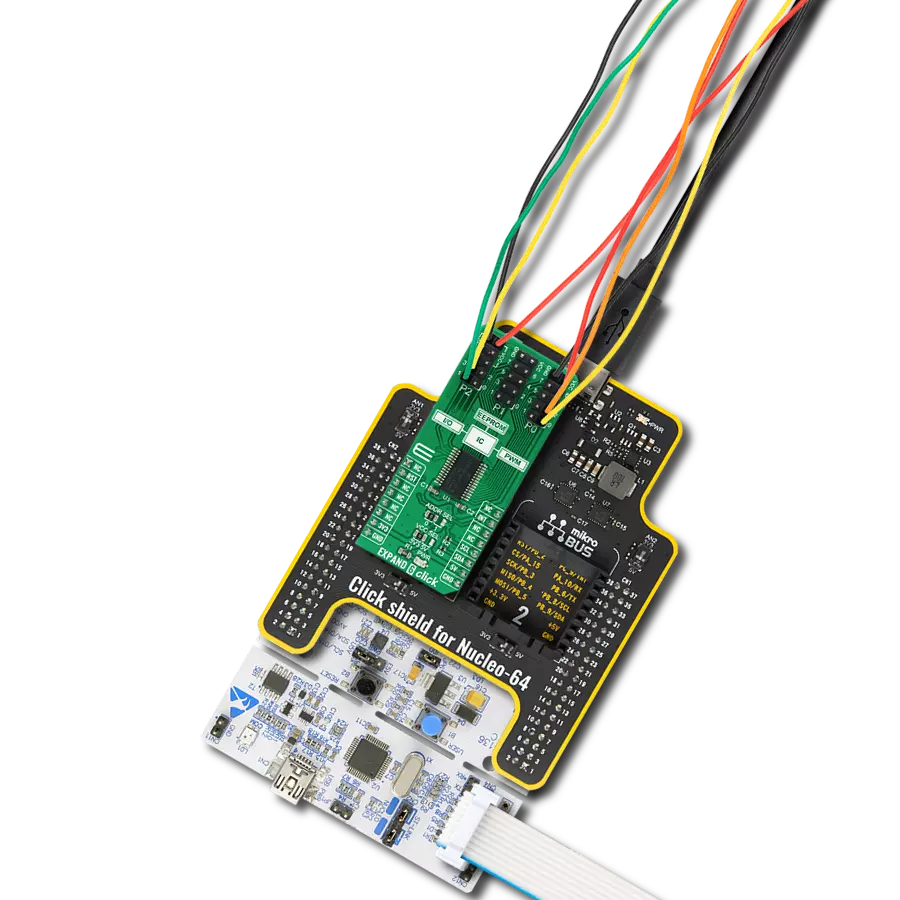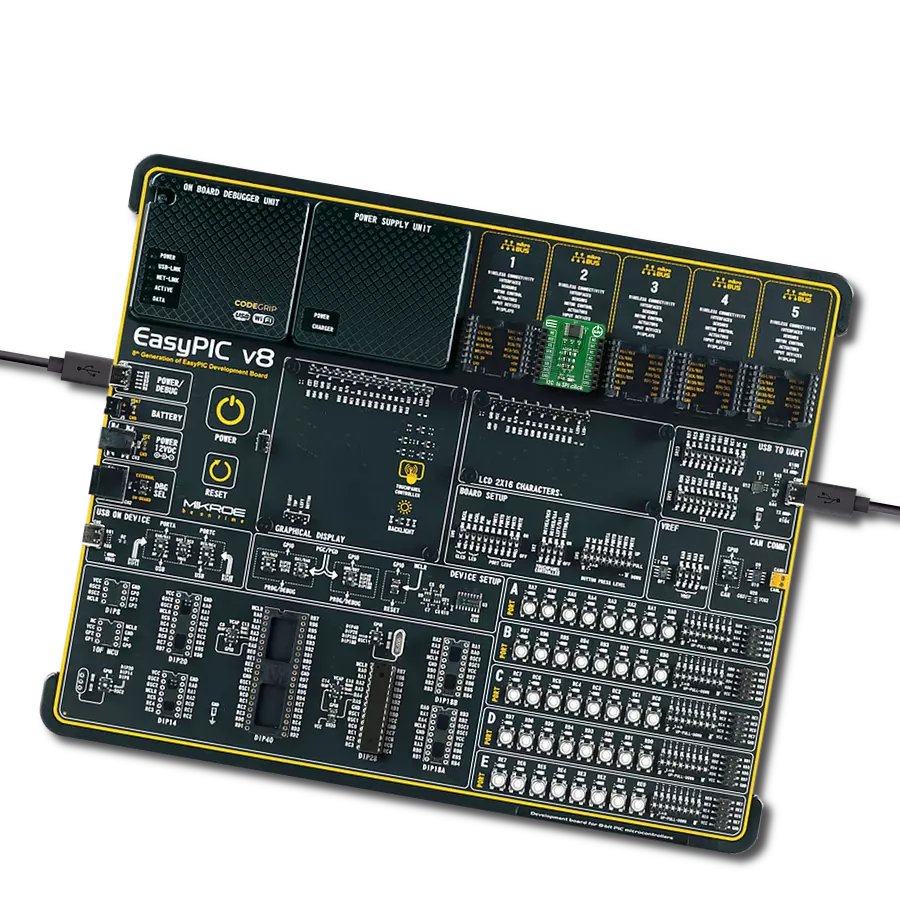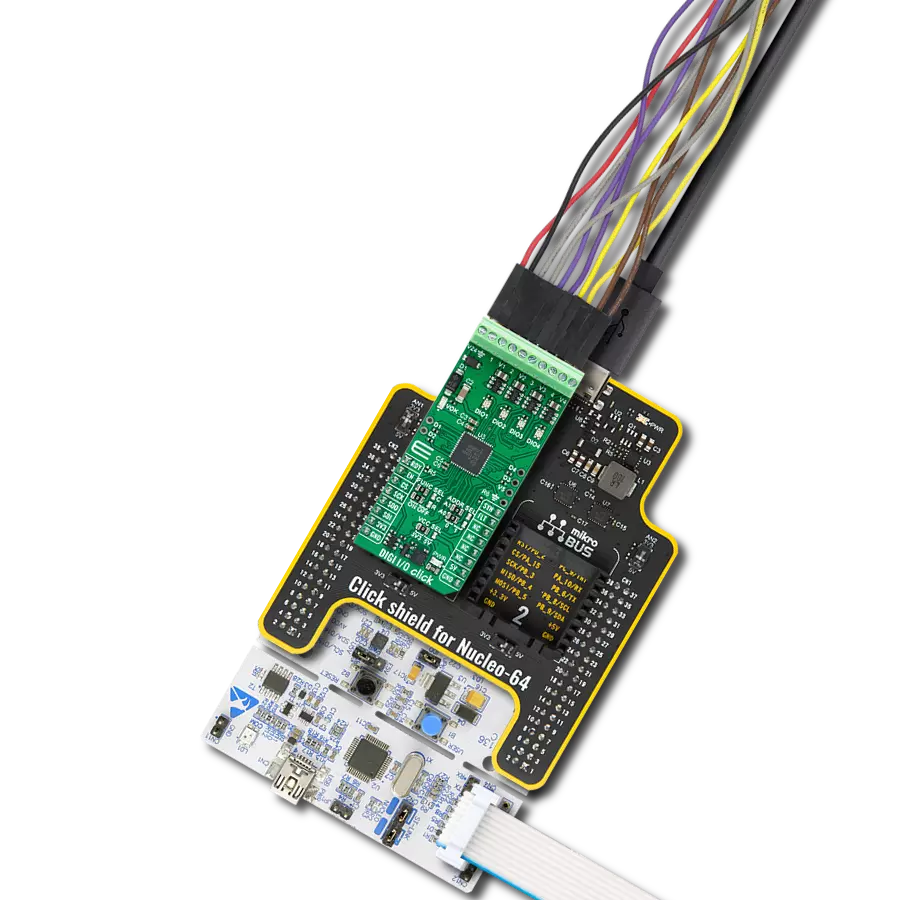Revolutionize data acquisition and control applications by integrating our multi-port I/O expander, simplifying the management of multiple inputs and outputs with bi-directional flexibility
A
A
Hardware Overview
How does it work?
Expand 9 Click is based on the SX1509QB, a 16-channel lowest voltage level shifting GPIO expander from Semtech Corporation. The expander devices, like this one, can provide additional control and monitoring when the MCU has insufficient I/O ports or in systems where serial communication and control from a remote location are advantageous. The SX1509QB has a built-in level shifting feature, making it highly flexible in power supply systems where communication between incompatible I/O voltages is required, thus eliminating extra-level translating circuits. The SX1509QB features a fully programmable LED driver with an internal oscillator for enhanced lighting control, such as intensity (via 256-step PWM), blinking, and breathing (fade In/Out), which makes them highly versatile for a wide range of LED applications. Also, keypad applications are supported with an on-chip scanning engine, enabling continuous
monitoring of up to 64 keys (8x8 matrix) without additional host interaction, reducing bus activity. Expand 9 Click communicates with MCU using the standard I2C 2-Wire interface to read data and configure settings, supporting a Fast Mode operation up to 400kHz. The selection of the I2C slave address is also possible using the ADD pin routed to the AN pin of the mikroBUS™ socket. This way, the SX1509QB provides the opportunity of the two possible different I2C addresses by setting the ADD pin to an appropriate logic state. In addition to selecting a Slave address, the SX1509QB can generate mask-programmable interrupts based on a falling/rising edge of any of its GPIO lines. A dedicated interrupt pin, routed to the INT pin of the mikroBUS™ socket, indicates to a host controller that a state change occurred on one or more of the expand lines, while the RST pin of the mikroBUS™ socket represents a Reset feature used to reset the chip at any time. Each
GPIO on I/O Expander channels is programmable via a bank of 8-bit configuration registers, including data, direction, pull-up/pull-down, interrupt mask, and interrupt registers. The user is also given an option of selecting the expander port supply voltage, which is realized by two onboard switches labeled as VCCA and VCCB, allowing one to choose between 3.3V and 1.8V. To obtain 1.8V, a small LDO regulator, AP2112 from Dialog Incorporated, is added to provide 1.8V out of mikroBUS™ power rail. This Click board™ can be operated only with a 3.3V logic voltage level. The board must perform appropriate logic voltage level conversion before using MCUs with different logic levels. Also, it comes equipped with a library containing functions and an example code that can be used as a reference for further development.
Features overview
Development board
Clicker 2 for Kinetis is a compact starter development board that brings the flexibility of add-on Click boards™ to your favorite microcontroller, making it a perfect starter kit for implementing your ideas. It comes with an onboard 32-bit ARM Cortex-M4F microcontroller, the MK64FN1M0VDC12 from NXP Semiconductors, two mikroBUS™ sockets for Click board™ connectivity, a USB connector, LED indicators, buttons, a JTAG programmer connector, and two 26-pin headers for interfacing with external electronics. Its compact design with clear and easily recognizable silkscreen markings allows you to build gadgets with unique functionalities and
features quickly. Each part of the Clicker 2 for Kinetis development kit contains the components necessary for the most efficient operation of the same board. In addition to the possibility of choosing the Clicker 2 for Kinetis programming method, using a USB HID mikroBootloader or an external mikroProg connector for Kinetis programmer, the Clicker 2 board also includes a clean and regulated power supply module for the development kit. It provides two ways of board-powering; through the USB Micro-B cable, where onboard voltage regulators provide the appropriate voltage levels to each component on the board, or
using a Li-Polymer battery via an onboard battery connector. All communication methods that mikroBUS™ itself supports are on this board, including the well-established mikroBUS™ socket, reset button, and several user-configurable buttons and LED indicators. Clicker 2 for Kinetis is an integral part of the Mikroe ecosystem, allowing you to create a new application in minutes. Natively supported by Mikroe software tools, it covers many aspects of prototyping thanks to a considerable number of different Click boards™ (over a thousand boards), the number of which is growing every day.
Microcontroller Overview
MCU Card / MCU
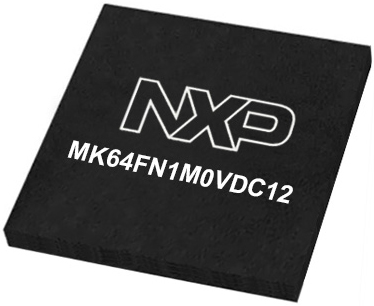
Architecture
ARM Cortex-M4
MCU Memory (KB)
1024
Silicon Vendor
NXP
Pin count
121
RAM (Bytes)
262144
Used MCU Pins
mikroBUS™ mapper
Take a closer look
Click board™ Schematic

Step by step
Project assembly
Track your results in real time
Application Output
1. Application Output - In Debug mode, the 'Application Output' window enables real-time data monitoring, offering direct insight into execution results. Ensure proper data display by configuring the environment correctly using the provided tutorial.

2. UART Terminal - Use the UART Terminal to monitor data transmission via a USB to UART converter, allowing direct communication between the Click board™ and your development system. Configure the baud rate and other serial settings according to your project's requirements to ensure proper functionality. For step-by-step setup instructions, refer to the provided tutorial.

3. Plot Output - The Plot feature offers a powerful way to visualize real-time sensor data, enabling trend analysis, debugging, and comparison of multiple data points. To set it up correctly, follow the provided tutorial, which includes a step-by-step example of using the Plot feature to display Click board™ readings. To use the Plot feature in your code, use the function: plot(*insert_graph_name*, variable_name);. This is a general format, and it is up to the user to replace 'insert_graph_name' with the actual graph name and 'variable_name' with the parameter to be displayed.

Software Support
Library Description
This library contains API for Expand 9 Click driver.
Key functions:
expand9_set_ch_output_state- Expand 9 set channel output state functionexpand9_led_driver_config- Expand 9 LED driver configuration functionexpand9_soft_reset- Expand 9 software reset function
Open Source
Code example
The complete application code and a ready-to-use project are available through the NECTO Studio Package Manager for direct installation in the NECTO Studio. The application code can also be found on the MIKROE GitHub account.
/*!
* @file main.c
* @brief Expand9 Click example
*
* # Description
* This is an example that demonstrates the use of the Expand 9 Click board™.
* The library initializes and defines the I2C bus drivers
* to write and read data from registers.
*
* The demo application is composed of two sections :
*
* ## Application Init
* The initialization of I2C module, log UART, and additional pins.
* After driver initialization the app set default settings.
*
* ## Application Task
* This is an example that demonstrates the use of the Expand 9 Click board™.
* This example shows the capabilities of the Expand 9 Click by toggling each of 16 available channels.
* Results are being sent to the Usart Terminal where you can track their changes.
*
* @author Nenad Filipovic
*
*/
#include "board.h"
#include "log.h"
#include "expand9.h"
static expand9_t expand9;
static log_t logger;
void application_init ( void )
{
log_cfg_t log_cfg; /**< Logger config object. */
expand9_cfg_t expand9_cfg; /**< Click config object. */
/**
* Logger initialization.
* Default baud rate: 115200
* Default log level: LOG_LEVEL_DEBUG
* @note If USB_UART_RX and USB_UART_TX
* are defined as HAL_PIN_NC, you will
* need to define them manually for log to work.
* See @b LOG_MAP_USB_UART macro definition for detailed explanation.
*/
LOG_MAP_USB_UART( log_cfg );
log_init( &logger, &log_cfg );
log_info( &logger, " Application Init " );
// Click initialization.
expand9_cfg_setup( &expand9_cfg );
EXPAND9_MAP_MIKROBUS( expand9_cfg, MIKROBUS_1 );
err_t init_flag = expand9_init( &expand9, &expand9_cfg );
if ( I2C_MASTER_ERROR == init_flag )
{
log_error( &logger, " Application Init Error. " );
log_info( &logger, " Please, run program again... " );
for ( ; ; );
}
expand9_default_cfg ( &expand9 );
log_info( &logger, " Application Task " );
Delay_ms ( 100 );
}
void application_task ( void )
{
expand9_soft_reset( &expand9 );
Delay_ms ( 100 );
for ( uint8_t cnt = 0; cnt < 16; cnt++ )
{
expand9_set_ch_output_state( &expand9, cnt, CH_OUTPUT_ON );
Delay_ms ( 100 );
expand9_set_ch_output_state( &expand9, cnt, CH_OUTPUT_OFF );
Delay_ms ( 100 );
}
for ( uint8_t cnt = 15; cnt > 0; cnt-- )
{
expand9_set_ch_output_state( &expand9, cnt, CH_OUTPUT_ON );
Delay_ms ( 100 );
expand9_set_ch_output_state( &expand9, cnt, CH_OUTPUT_OFF );
Delay_ms ( 100 );
}
expand9_soft_reset( &expand9 );
Delay_ms ( 100 );
for ( uint8_t cnt = 0; cnt < 16; cnt++ )
{
expand9_led_driver_config( &expand9, cnt, EXPAND9_FREQ_DIV_1, EXPAND9_LED_MODE_LINEAR );
expand9_set_intensity( &expand9, cnt, 10 );
Delay_ms ( 100 );
expand9_led_driver_config( &expand9, cnt, EXPAND9_FREQ_DIV_1, EXPAND9_LED_MODE_LINEAR );
expand9_set_intensity( &expand9, cnt, 200 );
Delay_ms ( 100 );
}
for ( uint8_t cnt = 15; cnt > 0; cnt-- )
{
expand9_led_driver_config( &expand9, cnt, EXPAND9_FREQ_DIV_1, EXPAND9_LED_MODE_LINEAR );
expand9_set_intensity( &expand9, cnt, 200 );
Delay_ms ( 100 );
expand9_led_driver_config( &expand9, cnt, EXPAND9_FREQ_DIV_1, EXPAND9_LED_MODE_LINEAR );
expand9_set_intensity( &expand9, cnt, 10 );
Delay_ms ( 100 );
}
}
int main ( void )
{
/* Do not remove this line or clock might not be set correctly. */
#ifdef PREINIT_SUPPORTED
preinit();
#endif
application_init( );
for ( ; ; )
{
application_task( );
}
return 0;
}
// ------------------------------------------------------------------------ END
Additional Support
Resources
Category:Port expander




















